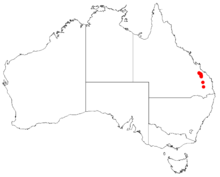Boronia palasepala
Boronia palasepala is a plant in the citrus family Rutaceae and is endemic to a small part of Queensland, Australia. It is an erect, rounded shrub with many branches, simple leaves and pink to white, four-petalled flowers.
| Boronia palasepala | |
|---|---|
| Scientific classification | |
| Kingdom: | Plantae |
| Clade: | Tracheophytes |
| Clade: | Angiosperms |
| Clade: | Eudicots |
| Clade: | Rosids |
| Order: | Sapindales |
| Family: | Rutaceae |
| Genus: | Boronia |
| Species: | B. palasepala |
| Binomial name | |
| Boronia palasepala Duretto[1] | |
 | |
| Occurrence data from Australasian Virtual Herbarium | |
Description
Boronia palasepala is an erect, many-branched shrub which grows to a height of 2.0 m (7 ft) with its branches covered with star-like hairs. The leaves are sessile, simple, elliptic to egg-shaped, 14–42 mm (0.6–2 in) long and 2–6 mm (0.08–0.2 in) wide with a dense layer of star-like hairs on the lower, paler-coloured side. The leaves have a winged petiole 1–8 mm (0.04–0.3 in) long. There is usually a single flower, sometimes up to three flowers arranged in leaf axils on a peduncle up to 0.5 mm (0.020 in) long. The four sepals are broadly egg-shaped to triangular, 4–6 mm (0.16–0.24 in) long, 3–4 mm (0.12–0.16 in) wide and hairy on the back. The four petals are pink to white, 8–10.5 mm (0.31–0.41 in) long, 4.5–6 mm (0.18–0.24 in) wide and hairy at first. The eight stamens alternate in length, size and shape. Flowering occurs from July to September.[2][3]
Taxonomy and naming
Boronia palasepala was first formally described in 1999 by Marco F. Duretto and the description was published in the journal Austrobaileya.[4] According to Duretto, the specific epithet (palasepala) is derived from Latin pala (spade) and sepala (sepal) and alludes to the spade-shaped (as in the playing card suit) sepals.[2] The botanical Latin word for "sepal" is sepalum.[5]
Distribution and habitat
This boronia grows in open eucalypt forest or woodland on sandstone from near Monto to Biloela in Queensland.[3]
Conservation
Boronia palasepala is classed as "least concern" under the Queensland Government Nature Conservation Act 1992.[6]
References
- "Boronia palasepala". Australian Plant Census. Retrieved 8 April 2019.
- Duretto, Marco F. (1999). "Boronia sect. Valvatae (Benth.) Engl. (Rutaceae) in Queensland, Australia". Austrobaileya. 5 (2): 280.
- Duretto, Marco F.; Wilson, Paul G.; Ladiges, Pauline Y. "Boronia palasepala". Australian Biological Resources Study, Department of the Environment and Energy, Canberra. Retrieved 9 April 2019.
- "Boronia palasepala". APNI. Retrieved 9 April 2019.
- Stearn, W.T. (1983). Botanical Latin. History, grammar, syntax, terminology and vocabulary. (3rd edition). Newton Abbot London: David Charles.
- "Boronia palasepala". The State of Queensland Department of Environment and Science. Retrieved 9 April 2019.